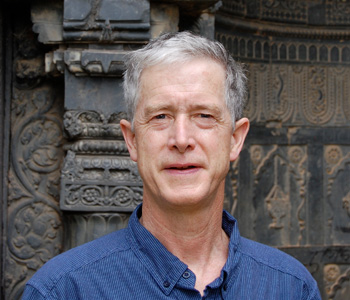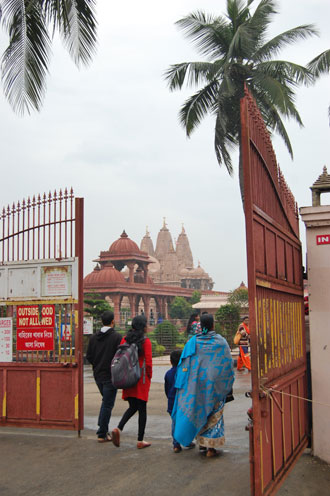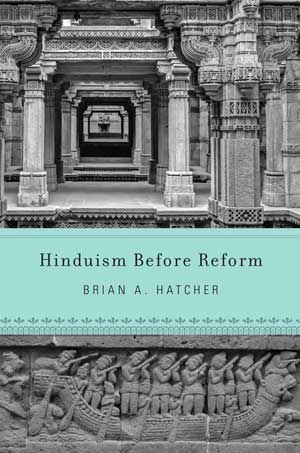
This is an ambitious book that grew out of a rather simple question. Around the turn of the nineteenth century, two Hindu leaders on either side of the subcontinent created new religious organizations. Each transformed their local contexts and also transcended them to become influential on the global stage. The strange thing is, only one of these leaders, Rammohun Roy (1772-1833), would go on to figure prominently in the literature on modern Hinduism. The other, Sahajanand Swami (1781-1830), has been largely overlooked by scholars. Why is that?
The answer boils down to a single word, “reform.” Reform is an interpretive category and narrative trope that has structured modern accounts of Hinduism since the moment Rammohun and Sahajanand first came to the attention of western observers. Even though both men were labelled reformers during their careers, it was Rammohun alone who became the face of Indian reform. To appreciate why, it helps to know that Rammohun was active at the epicenter of British rule in Bengal, while Sahajanand promulgated his teachings far from the cosmopolitan salons of Calcutta. Within the discursive chronoscape of reform, Rammohun figures as central and progressive, while Sahajanand is rendered peripheral and backward looking. And so the dominant narrative of modern Hinduism takes shape.
As a scholar of modern Bengal there was much to recognize in this story. And yet as a scholar of modern India, it is also clear how radically the landscape of religion is shifting. The current Prime Minister represents a political party committed to a brand of Hindu majoritarianism at odds with the vision of Rammohun. He also hails from Gujarat and represents the face of post-liberalization India, with its middle-class aspirations. Today Rammohun’s Brahmos are a vanishing community, while the followers of Sahajanand have built a massive temple-museum-theme park in India’s capital. It all strains the seams of the familiar narrative.
Clearly the time has come to rethink the accomplishments of Rammohun and Sahajanand and to search for new ways to tell the story of modern Hinduism. To do that we need to step back “before” the concept of reform came to exercise its critical pull on modern accounts of Hinduism. This requires, to begin with, attending more closely to the early colonial moment when Rammohun and Sahajanand were both active. This was a distinctive moment and must not be too quickly conflated with the later era of high imperialism. Equipped with a better understanding of their times, we then need to adopt a new set of tools for making sense of what they accomplished and how; we need tools not already shaped by the presuppositions of reform. I therefore buck convention and treat Rammohun and Sahajanand not as reformers but as religious lords at the head of two new religious polities—the Brahmo Samaj and the Swaminarayan Sampraday, respectively.
One could rightly say this is not a book about modern Hindu reform movements; it is a book about two colonial religious masters, each of whom embodied—and traded on—a distinctive mode of religious sovereignty. To think of Rammohun and Sahajanand as lords in this way is unsettling, not least for those accustomed to viewing Rammohun at the vanguard of India’s march toward enlightenment and freedom. Nonetheless, I take the risk because we do not need another history of Hindu reform; we need to revisit the period and their lives in a way that can help us reckon better with the India we see today. It may be unsettling, but much can be done by bringing together Bengal and Gujarat, Rammohun and Sahajanand, in ways that have not been done before.
Typically, the origins of modern Hinduism are traced to a single place, a decisive moment, and a compelling religious figure. The place is Bengal or, to be more specific, Calcutta. The moment is the turn of the nineteenth century, just as the East India Company began to imprint its policies and propagate its institutions in South Asia. And the figure of interest in this place and this moment is routinely said to be Rammohun Roy, the celebrated “Father of Modern India.” To Rammohun is traced the beginning of India’s modern reformation. Analogies to Luther are made, suggesting Rammohun’s goal was to return Hinduism to its roots, purify it of “medieval” error, and render its scripture accessible to all. With the creation of the Brahmo Samaj, Rammohun is understood to have set in motion a wave of change that would in time sweep across the subcontinent, revitalizing Hinduism and setting India on the path to freedom.
Hinduism Before Reform asks us to hit the pause button long enough to imagine another scenario. To do so the book introduces a second figure, someone who also took advantage of the early colonial moment to propagate a compelling religious message and establish a new religious polity. And rather than assuming Sahajanand Swami was a provincial figure working on the periphery of power, I remind readers of the active British presence in early nineteenth-century Gujarat; and I call attention to Sahajanand’s astute efforts to insert the Swaminarayan Sampraday into the socio-political landscape of Gujarat. Ironically, this actually led some observers to dub him a reformer. Some even compared him to his contemporary, Rammohun, who was just then gaining widespread fame as a reformer in his own right.
Yet the two men differed radically, and we discover that the plausibility of the reform narrative is strained from the very start. For one thing, we can no longer speak of one epicenter and one heroic reformer. We must now reckon with two fluid landscapes and two innovative religious lords. Both may have been styled reformers, but what did that imply? The reforms of Rammohun were celebrated for their resistance to the “medieval” world of Hindu images and polytheism, but in Sahajanand one had to do with a guru whom followers revered as an incarnate deity, if not supreme Lord. Finally, while apologists for the nascent empire sang the virtues of progress, some British observers argued that Sahajanand’s strict disciplinary code would help underwrite Pax Britannica. Over in Bengal, Rammohun was making much more radical noises.
One begins to appreciate that the story of reform in India is a story predicated on a set of recognizable, but not always reconcilable values—Protestant notions of true religion, British imperial visions for the improvement of India, and even (by the later nineteenth century) nationalist commitments to Indian awakening. The teleology should be evident. India was to become independent. What story best explained the journey from colonial subjection to national freedom? The story of Hinduism moving from backwardness to progress, from the medieval to the modern. And so Rammohun became the father of modern India, not Sahajanand. It could be no other way. These discursive threads were effectively tied off with the rise of what I call the Empire of Reform, the late nineteenth-century crystallization of history and metaphor that generated the chronoscape of Hindu reform.
But as I have noted, this does not seem to be how the story has trended over time. Today the Swaminarayan Sampraday is among the most globally visible of modern Hindu movements. The vast wealth and material exuberance of the community is on display from New Delhi to New Jersey. Meanwhile, the modest houses of worship first established by the Brahmo Samaj are nearly forgotten and a century’s worth of Brahmo cultural production is heritage more than habitus. For when it comes to religious appetites, India’s new middle classes are increasingly oriented to the sumptuous world of Sahajanand; the high-toned Vedic religion (aka Vedanta) of Rammohun has become the generic spirituality of the day.
When it first dawned on me that Rammohun and Sahajanand were nearly exact contemporaries my immediate thought was: What a wonderful opportunity to bring into view the character and complexity of a short-lived moment in South Asian history. One of the things I try to do is to provide a sense for what is distinctive about the period from roughly 1750 to 1850. I refer to this as the early colonial period in order to stress that many of the developments we associate with “colonialism” in India are features of a world that only really began to emerge after the 1857 Rebellion. The early colonial period, though colonial had not yet become the British Raj. As such, when one looks at this earlier moment, one notices it is less rigidly structured by racist attitudes; that the actors on the ground, Indian and Briton, often inhabited shared spaces and enacted shared agendas. This is not to ignore the implementation of colonial legislation, the devastating economic policies of the East India Company, nor the fact of British supremacy; but it is to say that the early colonial moment was one in which a figure like Rammohun could articulate his leadership in relation to Indo-Persianate norms of learning and ethics while cultivating British connections to advance his religious agenda. Similarly, a figure like Sahajanand, who is often pictured as being aloof from British power, was in fact deliberate in his efforts to meet East India Company officials and open to theological discussions with Christians in the area.
Chapters like “Fluid Landscapes” work to bring these issues to light by sketching economic, political and religious life in early colonial Bengal and Gujarat. One has a chance to appreciate the agency of various actors like peasants, landholders, urban merchants, and nouveaux riches, not to mention the complex legacy of mendicant communities and devotional polities. Here the historiographical goal is to move beyond the still prevalent idea that eighteenth-century India was the site of economic decay and socio-political anarchy. One can easily appreciate how this trope has helped underwrite both imperialist and nationalist narratives of reform. Once one commits to looking anew at this period, one realizes that the era of Rammohun and Sahajanand was one of incredible fluidity and immense opportunity.
So here we are. Today Calcutta is known as Kolkata and the city is sprouting skyscrapers and mega-malls. The tenor of politics is changing too, as decades of Marxist leadership have given way to new electoral tensions. Some of the parties making headway in Bengal today would have been almost unimaginable in pre-liberalization Calcutta. The Hindu majoritarianism of the BJP is making striking inroads, and side by side with the gleaming skyscrapers one spots the distinctive spires of North Indian nagara temples. It seems as if the twain has finally met—Rammohun’s Calcutta must make room for the Swaminarayanis (see image).
For many, changes like this strike a dissonant chord. And I am not thinking only of the spiritual and cultural heirs of Rammohun. Scholars of religion in modern India are themselves confronted with the challenge of rethinking some of their most cherished teleologies around progress in Indian religion and public life. Hard questions arise. Does the rapid expansion of the Sampraday in the past few decades register the return of the repressed in modern religious life? If the modern comparative study of religion has tended to celebrate the sober Vedantic inclusivism inaugurated by Rammohun, how will our textbooks make sense of the current landscape, with its soaring temples and exuberant devotional communities? If we continue to tell the story of modern Hinduism in terms of the inevitable spread of progressive religion across South Asia, we paint ourselves into an interpretive corner. Not only do the terms of our comparisons fail, but we face the uncomfortable challenge of confronting the colonial genealogy of our own disciplinary tools. But this is a task we must undertake. Along the way we should strive to develop new analytical tools, such as the model of religious polity construction I offer—tools that will allow us to bring together for comparison what scholarly accounts have for so long kept asunder. In the present-day confluence (or collision) of Gujarat and Bengal we face the challenge of assessing anew the place of religion in 21st century India.



Brian A. Hatcher is Professor and Packard Chair of Theology in the Department of Religion at Tufts University. He is a scholar of religion in modern South Asia, with a special interest in colonial Bengal. He is the author of several monographs, including Idioms of Improvement: Vidyasagar and Cultural Encounter in Bengal (1996) and Bourgeois Hinduism, or the Faith of the Modern Vedantists (2008). He is currently researching the rise and fall of a Hindu monastic network in modern Bengal.